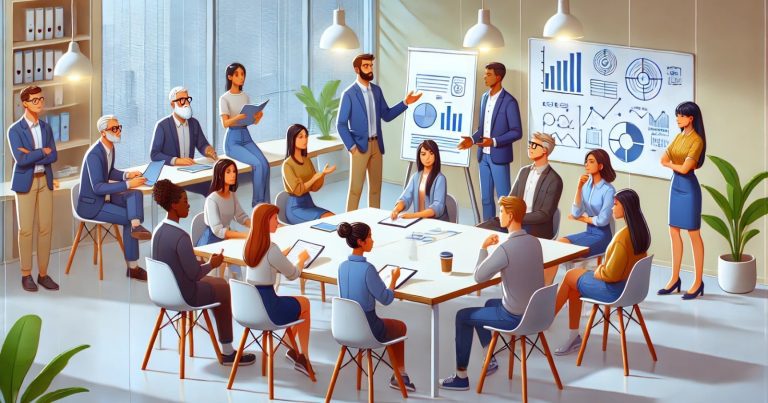Communication is exchanging information, ideas, or emotions between individuals or groups through speech, writing, or other media. Group Communication is the exchange of information, ideas, and opinions between group members to reach a common objective. It is very important in the workplace, schools, and society to assist individuals in working together effectively. Whether it is a business group discussing a project or students engaging in a group discussion, successful communication skills are necessary. Being familiar with different types of group communication, their significance, and their benefits makes one a better communicator in both personal and professional life.
What is Group Communication?
Group communication is a communication process among three or more people with a common goal and the need to share information. It can be verbal, non-verbal, written, or electronic. Effective group communication helps ensure clarity, cooperation, and decision-making effectiveness.
Group communication includes formal presentations and meetings to spontaneous discussion and brainstorming. These differences allow groups to be flexible to their needs, balancing planning and spontaneity of ideas. Open lines of communication and active listening could further increase the productivity of group communication and increase group satisfaction.
Group Communication Channels
Effective group communication is important for goal accomplishment and smooth team collaboration. Communication can be accomplished in different ways, each with pros and best application scenarios. The following are some popular modes of communication in teams: face-to-face meetings, conference calls, digital messages, and memos.
Face-to-Face Meetings
With an in-person team meeting, a group is present in a single location. It communicates about their progress toward a common goal, determines areas to improve, and commends the efforts of other members. This group communication channel can prove useful for teams with a specifically defined leader, like a manager or project coordinator. These leaders may establish the goals of the meeting, offer an agenda and get feedback from the other group members.
Conference Calls
A video call or conference works much like a team meeting but in such a way that remote employees can participate in the conversation from wherever they happen to be working. Everyone enters the call on a conference line or video conferencing tool to review the task. A conference or video call is good if one person makes the call so that no one is confused about when or how it occurs. This communication vehicle can also be perfect when a group wants to communicate with other important project stakeholders who might not work within their organisation.
Digital Messages
Electronic messages via email or online messaging portals facilitate more relaxed communication among group members than team meetings and video calls or conference calls. In this medium, group members can exchange digital messages to share ideas, pose questions, and share their progress. Due to the technology’s instantaneous capacity, members can exchange information faster via this avenue than other options. This is also a suitable option when it is not definite who the group leader is because they all have the same availability to the technology.
Memos
A memorandum, or a memo for short, is a written message sent out by one of the group members to others. Memos are formal group communication and generally include significant information regarding the group task. A memo typically adopts a letter format and provides for the memo’s date, the recipients and a subject line before the message. This communication channel can be effective when those working in the same office require exchanging sensitive or confidential information about their project.
Types of Group Communication
Different situations require different communication methods. Below are the types of group communication commonly used in workplaces, schools, and social settings.
Formal Group Communication
Formal group communication occurs within an organised environment such as a business meeting, seminar, or classroom. It has defined roles, like leaders, moderators, or presenters, and follows established protocols and rules to keep the conversation in order. Such communication is critical for constructive decision making. A group can also communicate formally, e.g., an executive meeting in a boardroom where leaders discuss the company’s performance.
Informal Group Communication
Informal group communication, or casual communication, happens in unstructured settings like team lunches, coffee breaks, or casual office chats. This type of communication encourages the free exchange of ideas and helps build stronger relationships among team members. It is less about the formal flow of information and more about fostering a relaxed and friendly environment. For example, employees discussing weekend plans at a coffee break represents informal communication.
Virtual Group Communication
People use digital meeting platforms like Zoom, Microsoft Teams, or WhatsApp to communicate with each other in groups and work remotely. From video calls, instant messaging, and emails, you name it; depending on the teams’ geographical locations, it enables real-time teamwork. Virtual communication bridges the gap of distance and allows uninterrupted collaboration. For example, a multinational team discussing a project over video conferencing is an example of virtual group communication.
Small Group Communication
Small group communication involves a small number of people, typically 3 to 10, which ensures everyone can speak. It is common in classroom discussions, team brainstorming sessions, and study groups. This type of communication encourages active participation and facilitates quick decision-making. An example of small group communication is students discussing exam strategies in a study group.
Public Group Communication
Public group communication involves one person or a panel communicating with a large audience, often in seminars, public speeches, or press conferences. It requires strong public speaking skills and the ability to engage and connect with the audience. Public group communication is key in delivering important messages to large groups. An example is a politician addressing the public during an election campaign.
Importance of Group Communication
At both a personal and professional level, group communication largely involves finding success. Responsibility for group communication: You cannot overlook the value of effective group communication as it directly impacts productivity, relationship building, and decision-making. Here’s why it is important:
- Boost Collaboration and Teamwork: Leads to sharing ideas and solutions to problems within teams. Partitions listeners into a group that is mutually supportive and trustful. Helps achieve better project outcomes and make well-informed decisions
- Better Communication Skills in Group Discussion: The right skills to put their thoughts into words. Promotes active listening and providing purposeful feedback. Helps with presentation and negotiation skills.
- Helps with the Decision and Problem Solving: Groups consider various angles before making decisions. It encourages brainstorming and creativity. It helps businesses develop innovative solutions to challenges.
- Builds Stronger Relationships: Encourages bonding and trust among team members. Reduces misunderstandings and conflicts. It helps in developing a positive work or study environment.
- Adapts to Technological Advancements: Modern workplaces use virtual group communication to connect global teams. Digital tools help improve productivity and coordination. Social media platforms enable effective public engagement.
Advantages of Group Communication
Successful group communication is the foundation for success and teamwork in any environment. Efficient, innovative decision-making capabilities are heightened through effective group communication, allowing for overall organisational and business expansion. Some of the main advantages of effective group communication are below.
- Increases Efficiency and Productivity: Effective group communication speeds up decision-making by gathering diverse opinions from team members. Members break up production into smaller tasks according to the individual’s strengths, and thus, businesses can complete a project faster, working collaboratively as a team. Increased coordination helps projects get completed on time, assisting organisations to remain competitive while meeting deadlines easily.
- Enhances Learning and Knowledge Sharing: It enhances learning and knowledge sharing. Group communication allows members to share their thoughts freely and learn from each other. By exposing individuals to alternative viewpoints and specialities, it aids in the process of continuous learning in schools and professional settings. When team members work together, they learn from each other, building the knowledge of the group and encouraging individual and collective growth.
- Encourages Creativity and Innovation: When team members communicate in a group, brainstorming and idea generation happen. This creative ecosystem allows businesses and teams to develop innovative solutions and new ways of viewing ideas. The more varied perspectives and experiences teams share, the better they can innovate; this propels business, allowing it to scale and stay on the cusp of its industry.
- Strengthen Relationships and Decrease Conflicts: Team communication promotes open conversations, making misunderstandings lesser and relationships stronger. Transparency enhances coordination in families, workplaces and social groups. Positive communication skills are the foundation for collaborative problem-solving between people (or groups) without disagreement.
- Facilitates Better Decision-Making: Having different perspectives in group discussions encourages making informed decisions. This ensures no one-sided or biased decision-making and that all viewpoints are considered. Decision-making will be far more balanced, effective and in the organisation’s or group’s best interest when various perspectives are considered.
Components of Group Communication
Successful group communication is critical for working together and obtaining common objectives. For communication to function effectively in a group, certain essential elements should facilitate the successful delivery and reception of messages. The following are the major elements of effective group communication.
- Sender and Receiver: Communication is initiated by the sender and interpreted by the receiver. In group discussions, multiple people will send and receive the information. Establishing clear roles and practising active listening is critical to ensure that messages are sent accurately and receive full understanding by all involved parties.
- Message: The communication content, including ideas, opinions, instructions, etc. The message should be precise, cover most aspects, and be well-organized so the recipient is not confused. You straightforwardly convey the message, and chances are that the communication will be effective. The receiver will also know how to interpret the information correctly if a message is concise.
- Message Delivery: It can be verbal, written, or below mediums. This has been the case with face-to-face meetings, emails, and video calls. Based on the situation and the audience, one should choose a medium so that the message reaches the correct recipient.
- Feedback: Feedback gives you an understanding of what you send to others. It helps the sender and receiver know that the message was rightly understood. It also helps improve future communication effectiveness by providing insight into how messages are perceived and what could be done better next time.
- Noise: Noise refers to any barrier that affects message delivery, such as technical issues, language differences, or distractions. Reducing noise is essential for smooth communication flow, as it minimises misunderstandings and ensures that the intended message reaches the receiver without interference.
The Role of Technology in Group Communication
Technology has also advanced group communication significantly, making it faster and more efficient. Video conferencing software and virtual meetings using Zoom and Microsoft Teams facilitate real-time collaboration worldwide. Instant messaging applications like Slack and WhatsApp increase instant messaging capabilities, and emails are ideal for formal documents and communication. Cloud collaboration software such as Google Drive and Trello facilitates document sharing and project organisation, enhancing productivity.
Social media sites like LinkedIn, Twitter, and Facebook enable businesses to interact with the public and post their brand messages. The technology facilitates easy communication and links between places in favour of companies and teams.
Group Communication FAQs
1. What are the categories of group communication?
The primary categories are formal, informal, virtual, small group, and public communication.
2. What is informal group communication referred to as?
Informal group communication is unstructured or casual, usually in social or work environments.
3. What are some examples of group communication?
Some examples are team meetings, classroom discussions, video conferencing, and brainstorming sessions.
4. Why is group communication significant?
Group Communication is important for team collaboration, problem-solving, decision-making, and relationship-building.
5. What is the effect of technology on group communication?
Technology enhances remote working, instant messaging, and virtual meetings, which enhance group communication.


